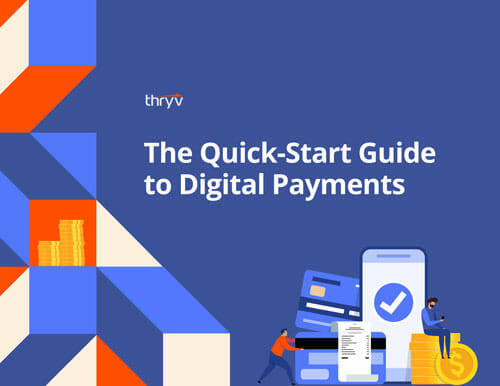Pay for supplies: Check. Settle your vendor bills: Check. Pay your employees: Check. Now, have you paid yourself?
Business owners pour their hearts and souls into ensuring their companies stay afloat. Unfortunately, passion doesn’t pay the bills, and you probably don’t want to work for free. You have to decide whether you’ll take an owner’s draw vs. a salary from your business.
If you’re not super familiar with those options, or just struggling to figure out how to pay yourself, you’re not alone. The good news is that you’ve got options, so let’s take a moment to explore the difference between owner’s draw and salaries.

Quickstart Guide to Digital Payments
DownloadWhat is an owner’s draw?
An owner’s draw is when the owner takes funds from the business for personal use. Pulling these funds can be done regularly or when needed, and they don’t offer tax deductions. Many small business owners do this rather than a salary because it provides more flexibility and pays you based on company performance.
What is a salary?
A salary is an incremental payment given out over time. Owners receive a fixed paycheck weekly, bi-weekly, or monthly, which amounts to an annual salary.
For example, if my paycheck were $1K/week, my salary would be $52K/year (taxes not included).

Owner’s draw vs. salary: Which is better for your business? That depends on a few factors. Let’s explore more in the section below.
Owner’s Draw vs. Salary (ft. snippet)
An owner’s draw is a one-time payment pulled directly from your revenue, while a salary is a recurring payment received throughout the year.
When determining which is best, take a step back and examine your business. Every decision has pros and cons, especially when it comes to payment options as a business owner.

The Advantage of Owner’s Draw
The advantage of an owner’s draw is flexibility. You can pay yourself based on the business’s performance.
For example, Charlie owns a tuxedo shop that’s an S Corporation. He decides to pay himself a salary of $2,000/month as the company owner, but rather than do it via payroll, he collects payment through a check that his business writes. When Charlie’s shop is busy, he pays himself a little extra based on his business’s cash flow.
Remember that the owner’s draw is considered taxable income, and taxes won’t be deducted automatically. At the end of each year, Charlie will need to tuck money aside for federal, state, and self-employment income taxes.
The Disadvantage of Owner’s Draw
An owner’s draw reduces your business’s equity, reducing funds for future spending.
Avoid taking large payments if you’re considering using an owner’s draw. Large draws can put your business in the red and leave you at risk of closing.
Let’s look at Charlie’s tux shop again. He has $120K in owner equity, including his original $50K contribution and earnings from past years. If Charlie takes out $100K worth of an owner’s draw, he risks being unable to pay employees’ salaries, fabric costs, and other expenses.
The Advantage of Salaries
On the other hand, a salary offers a bit more stability.
Let’s say our friend Charlie decides to pay himself a salary. Taxes will be taken out automatically, and his compensation will be consistent.
With a salary, tracking income and expenses is straightforward, and any bonuses paid out are taxed.
The Disadvantage of Salaries
The disadvantage of this route is a smaller take-home pay. You can’t give yourself a little extra if the business does well.
Additionally, if your business has a down month, your paycheck becomes another expense when distributing your employees’ checks.
Taxes also play an important role in this decision because your business classification impacts how you can pay yourself.
Owner’s Draw vs. Salary: Classification
Each business structure has its own rules when it comes to owner compensation.
For example, if Susan’s hair salon is a partnership, she can’t collect a salary because, according to the IRS, you can’t be a partner and an employee simultaneously.
Did we just open a can of worms? Yes, we did.
Have no fear. Here are our recommendations for owner compensation based on your business type.
- C Corporations: Owner’s Draw
- S Corporations: Both
- Sole Proprietorships: Owner’s Draw
- Limited Liability Companies (LLC): Owner’s Draw
- Partnerships: Owner’s Draw
Now, let’s get to the good stuff. How do your taxes work?
Is owner draw taxable? Ft. snippet
Yes. Owner’s draw is taxable income. It’s not taxed immediately when drawn, but it is accounted for at the business tax deadline.
Again, your business classification affects how you are taxed. For example, C Corps are subject to double taxation, which means they can be taxed at two different times. They’ll be taxed at the federal tax rate and then again on capital gains.
There are also self-employment taxes. Sole proprietorships and partnerships pay these as part of their Social Security and Medicare contributions.
How are owner’s salaries taxed?
Small business owners with a salary use a W-2 to pay those taxes through wage withholdings. S Corps, however, don’t pay self-employment tax because company owners who work as employees have to be paid a reasonable salary, per IRS guidelines. A “reasonable salary” should “be commensurate with your duties,” and the IRS recommends checking with public libraries to find “averages of compensation paid for various types of services.”
Determining how to pay yourself is one thing. Figuring out how much to pay yourself is a whole other ballgame. We’ll help you figure that out in the next section.
How does the owner of a business get paid?
There’s no exact formula for paying yourself as a business owner. It depends on your industry, size, and company structure. It also depends on your business goals. For instance, some owners can afford to take a smaller salary and reinvest that money back into their business.
Here are some factors to consider when determining your compensation:
- Business Structure: It’s important to understand your business structure and how it will be taxed.
- Business Performance: Revenue, profit, and expenses impact how much you can pay yourself.
- Growth: Consider your business needs. For example, are you a startup that needs to focus on reinvesting rather than pocketing profits for compensation?
- Sustainability: The IRS will raise brows if you only take a $20K salary. Check their guidelines to determine what a reasonable salary looks like.
- Personal Needs: Whether it’s a mortgage, rent, or savings account, make sure you can cover your needs with your pay.
These details give you a better idea of how much you can realistically pay yourself as a business owner. It can also be helpful to consult an accounting, tax, or legal advisor to inform your business decision.
Owner’s Draw vs. Salary: Choosing the Right One
Paying yourself shouldn’t be stressful; it should be one of the fun parts of managing your business.
If you need help, use a payment processor paired with payroll software. It can track your expenses, send invoices, and provide information about how you can structure your business. With these tools, you’ll have everything needed to make smart decisions that reward your hard work and keep your business growing.

The Quickstart Guide
to Digital Payments
All you need to know about small business payment processing.




